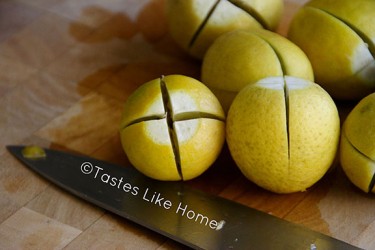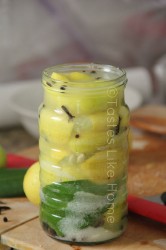Hi Everyone,
Limes are currently in season and it is usual that when certain fruits and vegetables are bountiful, we find ways of preserving them for later and varied uses. Since last year I have been meaning to write to you about preserved limes but by the time I got around to it, limes were out of season. I also want to share with you several ways in which to use the preserved limes so I figured that since limes are now plentiful, we’d set about preserving some limes for use later.
Quartered, packed with salt and sitting in their own juices, preserved limes or lemons is an ingredient you will always want to have stocked in your refrigerator. The uses are many, and preserved limes bring a taste of North Africa, particularly Morocco to our tables.
Here’s the thing, it takes 4 weeks for the limes to be cured hence the head’s up from now. I did not want you to read a recipe and get frustrated with me telling you to make something only to find out that it takes a whole month to create one of the ingredients. Therefore, this is your official notice to set the limes so that 4 weeks from today you can start using your preserved limes.
While many people use the words lemon and lime interchangeably, they are not the same. Depending on the variety, the level of acidity can differ as well as the flavour. Lemons and limes come in many varieties, flavours, colours and shapes; there is Meyer lemon, Bajan lemon, kaffir limes, calamansi limes, eureka limes, California limes and our very own West Indian limes which are small, perfectly round,  yellow when ripe, with a thin skin and full of juice.
yellow when ripe, with a thin skin and full of juice.
Preserved lemons also known as pickled lemons are an essential condiment and ingredient in North African and Middle Eastern cuisines. Made with specific varieties of lemons found and grown in that part of the world, preserved lemons are a staple in many kitchens. The lemons used for preservation have a distinct flavour that enhances any dish to which they are added. Because limes are more widely available here in the Caribbean and in much larger quantities than lemons, I decided to make this famous North African condiment/ingredient using our limes. Based on all I have read and what I tasted a few years ago when I first had chicken with preserved lemons, I think that our limes work perfectly as a substitute – they are juicy, thin skinned and flavourful.
Each year when limes are in season and selling at a good price, I preserve them. Some in the style of Moroccan preserved lemons and others in the style of South Indian lime/lemon pickle. Each method of preservation reveals different flavours when used either as a condiment or ingredient. The most exciting thing for me is the transformation of this highly acidic fruit into something soft, briny, and citrusy that I can’t seem to get enough of. I am drooling just thinking about it.
Let me now tell you how to go about preserving the limes – Moroccan style – and then I’ll discuss how to use it.
Here’s what you will need:

Pack cut limes with salt (Photo by Cynthia Nelson) Fresh limes – the amount does not matter, you can use as few as 6 limes or as many as 2 dozen limes. Always have extra limes on hand as you will need to squeeze the extras for added juice to cover the limes.
- Sterilized glass bottles/jars with airtight lids. The size of jar/bottle will be determined by the quantity of limes you are preserving. The limes will shrink as they cure and soften.
- Salt – regular fine table salt will work, or if you have, use kosher salt or sea salt.
- Spices, herbs, whole hot peppers – these are all optional ingredients and absolutely not necessary. They bring added flavour to the preserved limes. For your first attempt, I’d say skip any of these optional ingredients but certainly give them a try on your future attempts.
With your ingredients assembled, here’s what to do:
- Wash the limes using a vegetable brush to get rid of any dirt that might be on them. This is important, as it is the skin/rind of the lime that is highly prized when preserved. Remove any remaining pieces from the stem and pat the limes dry. Cut them into quarters but not right through, leave about ¼-inch at the bottom intact.
- Scatter a tablespoon of salt at the bottom of the jar.
- Pack salt into the cut parts of the limes and add them to the jar one at a time. Each time you add a lime, press it down firmly to squish on top of the others and release its juice. Repeat this action – salting the limes, adding to the jar and squishing – until all of the limes have been added and lots of juice liberated.
- Sprinkle another tablespoon on salt on top of the limes.
- Squeeze a few more fresh limes and add the juice to the jar until the limes are completely covered with the juice. The limes must be completely covered with juice.
- Leave a little space at the top of the jar. Seal the bottle/jar with its cover and give it a gentle shake to mix.
- Store the jar on your countertop away from direct sunlight. At the end of the first week, give the jar a shake to mix up the ingredients and help the salt dissolve then leave it to cure for another 3 weeks.
- At the end of the 4 weeks, the preserved limes are ready for use. Transfer the bottle to the refrigerator until you are ready to use; the preserved limes will last up to a year in the refrigerator.
How to use:

Limes with spices & bay leaf (Photo by Cynthia Nelson) To access the preserved limes, use a wooden spoon or fork or a material that is not metal to pluck a lime from the bottle.
- Rinse the lime under cool running water to rinse off the excess saltiness. The pulp can be discarded but if your recipe calls for its use, do not discard it. The use of the flesh imparts a stronger lime flavour.
- Chop the rind into very fine pieces or according to the recipe being used and add to your dish as instructed by the recipe.
- Another way to store and use the preserved limes is to drain off the excess liquid, remove the seeds and puree the limes – rind and pulp, add back to jar in which it was cured and refrigerate.
Preserved limes can be added to the following for a limey citrus flavour:
- Curries – chicken, lamb, beef, veal, seafood
- Any seafood dish
- Sautéed vegetables
- Salads
- Salad dressings
- Roasts – chicken, lamb
- Choka(s) – tomato, eggplant, coconut, salt fish, smoked herring
- Buljol – pickled salt fish, smoked fish, smoked herring
- Sour, chutneys, relishes, salsas, dips
- Sauces
- Stews such as chickpea stew
- Puree or chopped and added to pepper sauce
- To flavour mayonnaise and aioli
- Pesto(s)
- Spreads such as sardine and tuna for sandwiches
- Dhal(s)
- North African style dishes, particularly the stews
Go get yourself some limes and preserve them and we’ll meet back here in a month’s time with a couple of recipes to use your preserved limes as well as information on how to add them to the various dishes listed above.
Cynthia
Cynthia@tasteslikehome.org
www.tasteslikehome.org




